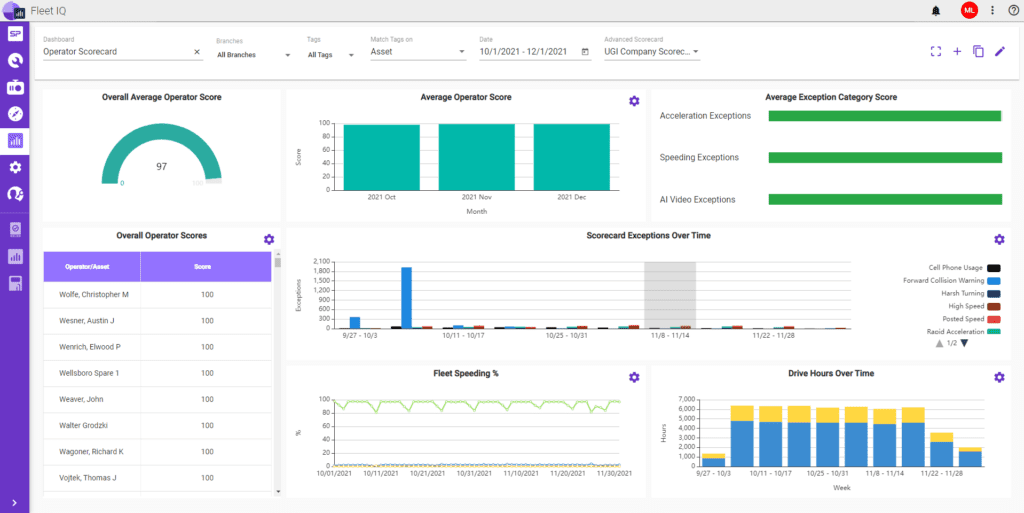To properly train and coach your fleet drivers, you need visibility into the common risky driver behaviors and their impact. Thanks to innovative vehicle telematics, the right data is just a drive away.
From hard braking to rapid acceleration and speeding, hazardous driving typically leads to more accidents and higher insurance rates. In fact, speeding is one of the best predictors of car crashes. As a fleet safety manager, it’s your job to continuously identify and correct these behaviors. And driver scorecards are one of the most effective tools available to get it done.
Use our guide to driver scorecards to learn how to incentivize individual drivers and improve your fleet safety and CSA score.
What Are Driver Scorecards?
Driver scorecards are a type of performance evaluation based on different driving metrics such as speeding, idling, and hard acceleration through the use of vehicle telematics. The purpose of driver scorecards is to track risky driving behavior across your fleet and work to correct them through a broader fleet safety program. Driver scorecards don’t just provide fleet-wide safety performance; they provide managers with insight into individual driver performance as well.
Typically, scorecards are part of a broader fleet telematics or safety management platform in the form of real-time dashboards. Because they are digital, both managers and drivers should have access to scorecards at all times. This visibility helps the entire team understand their goals and performance.
Fleet and safety managers use driver scorecards to inform ongoing driver coaching and training programs. Whether you’re coaching an individual driver or deploying fleet-wide safety initiatives, driver scorecards provide a useful barometer for how your efforts are impacting your fleet safety metrics over time.
How to Measure Driver Safety through Scorecards
You can measure driver safety using a variety of key performance indicators (KPIs) in three main categories. The three most important safety categories to measure include:
-
- Acceleration, which measures harsh braking, rapid acceleration, and hard turning. These behaviors affect wear and tear on tires and increase the odds of serious injury.
- Speed, which measures the rate of speed and time above posted speed limits. This behavior should be analyzed against company-defined speeding thresholds.
- Idling, which measures the time spent idling against company-defined goals. Idling can shorten engine lifespans and pose hazards making it a key metric to consider.
Old habits are easy to fall back on. That’s why driver training isn’t always enough on its own. Scorecards are a great way to measure how impactful your training program has been as you track these three safety categories over time.
Driver Safety Scorecard Template
Within the three categories of events, safety scorecards rely on a variety of aggressive driving habits such as speeding, braking, and acceleration. An effective scorecard will contain data insights for each of the most common risky habits in a visual format such as a table or graph.

Consider a general safety scorecard template like the dashboard above to give you a better understanding of the overall performance of your drivers. Your template should include the most common driving behaviors that lead to risk:
- Rapid acceleration: Accelerating too quickly affects the g-force of fleet vehicles, resulting in jolting.
- Harsh braking: Rapid acceleration frequently leads to harsh braking, resulting in a greater chance of rear-end collisions and wear and tear on tires.
- Speeding: Speeding is one of the best predictors of car crashes according to this study, resulting in increased odds of collisions and serious injury. Driver scorecards factor in both the top speed a vehicle traveled as well as the amount of time the vehicle spent above a posted speed limit.
- Idle time: Idling shortens the lifespan of engines and poses environmental hazards and health risks from vehicle emissions. Reducing idle time has many benefits including saving fuel and cutting these harmful emissions.
- Seatbelt usage: Seatbelts keep drivers safe in the event of an accident, preventing serious injury.
Each of these driver habits measures the likelihood of incidents occurring, making it essential to track and gauge on an ongoing basis. Doing so will not only inform safety measures but also motivate drivers to perform better by incentivizing competition. This will lead to fewer accidents and lower insurance rates in the long term.
Additional Tips for Creating Safety Scorecards
To create effective driver scorecards, you can use a solution that combines vehicle telematics and AI dash cam capabilities. AI dash cams and in-cab driver coaching is shown to reduce accidents by up to 60%, making it essential to gain 360-degree visibility and add a proactive component to your safety program.
The right telematics software should help break down data silos, connecting all safety metrics in one place. Here are some additional tips to improve your safety scorecards.
1. Set Fleet Goals and Use Scorecards to Gamify Safety
Setting goals can help you reach new levels of fleet efficiency and safety. Goals can help you improve safety, increase the lifespan of fleet vehicles, and lower insurance costs. Consider goals related to compliance regulations, driver behavior, and fleet assets such as software capabilities. These will all help you prevent accidents, reduce wear and tear on vehicles, and contribute to a more sustainable fleet.
Once your fleet-wide goals are communicated to your entire team, you can use your scorecard dashboards as a visual tool for everyone to see their performance. Reward drivers that are at the top of the leaderboard, or are showing the most improvement week over week. This will create some friendly competition and give drivers another reason to practice defensive driving.
2. Leverage AI Video Data
Take your driving data one step further by leveraging AI Video in addition to telematics. Evaluating this footage gives you a more complete assessment of driver safety, providing visibility and context around the behaviors that are dinging your drivers’ scorecards.
Use this insight to inform your safety protocols. You can also use dash cam footage to help with training, using the visual evidence to help drivers understand how certain behaviors lead to negative outcomes. The context you gain from dash cam footage can also help you refine the events your driver scorecards prioritize.
Read: How to Select the Best Fleet Dash Cams
3. Create Weighted Scorecard Events
Whether you determine your fleet score based on FMCSA’s score or by using your own scoring scale, find a provider that supports advanced custom driver scorecards. Fleets are made up of unique sets of vehicles, use cases, settings and conditions. Shouldn’t the way you evaluate your drivers be custom to your business requirements?
To do this, create weighted scorecards based on the driving events that matter the most to your fleet. For example, harsh acceleration could take precedence over less risky behavior such as a delayed driver response. Or maybe you care less about a posted speed limit because you require your vehicles to drive under 50 MPH at all times. You’ll need to review data from both telematics and AI video dash cams to identify the behaviors that frequently lead to incidents for your fleet. Once you have the full picture, create a scorecard that weights each event according to your needs.


